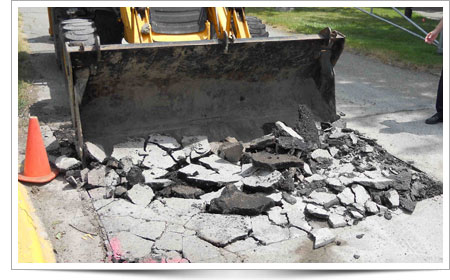Asphalt Installation Provided by Surface King

Your parking area is the first impression a visitor has of your business. Is your parking area clean, sealed, and well maintained or does it have potholes, parking lines that you can hardly see, and asphalt that is grey and oxidizing? Asphalt repairs may be necessary due to safety concerns or for aesthetic reasons of the property owner. When it’s time to have your pavement professionally repaired, call Surface King.
Those small cracks and depressions in your asphalt can cause a considerable amount of destruction. They provide places for water to work its way into and under the pavement and cause base erosion. When that water freezes in the winter, it expands, cracking apart the asphalt and even heaving up whole sections of the installation.
The three main repairs that can be done on asphalt surfaces are crack repair, pothole patching, and surface overlayment. While crack repair and pothole patching are relatively minor (but important) maintenance procedures, overlayment is a more significant task that may be undertaken if problems with the surface are widespread but the base layer is still in good condition.
Crack Repair
Crack repair is an essential asphalt maintenance procedure since water penetration is the worst complication for asphalt. The best defense against water intrusion is crack repair. Cracks in asphalt commonly begin at the bottom of the asphalt and work their way to the surface. Once a crack reaches the surface of your asphalt, the increased volume of water able to reach the base can dramatically deteriorate the foundation, weakening your pavement and causing “alligatoring” and potholes – which are more costly to repair. The intrusion of water is greatly reduced by properly sealing the crack. If not repaired, the crack will continue to spread and the pavement will eventually crumble. With proper maintenance including seal coating and striping, your asphalt can last much longer.
There are several reasons besides water erosion, why your asphalt may end up with cracks that require repair; poor base layer, an asphalt layer that’s too thick or thin, incorrect drainage, heavy traffic, tree roots, and extreme weather conditions. These reasons lead to:
- Fatigue or Alligator Cracks — Patterns of interconnected cracks
- Block Cracks — A series of large, fairly rectangular cracks
- Edge Cracks — Longitudinal cracks near the outside edge of the pavement
- Longitudinal Cracks — Often seen parallel to the pavement’s center line
- Transverse Cracks — Typically at right angles to the center line of the pavement
- Reflective Cracks — Usually located at joints in older layers of paving material
- Slippage Cracks — Due to a low-quality asphalt mix or poor bonding between layers
Pothole Patching
Potholes form on asphalt surfaces of parking lots, subdivisions, and municipal roads due to the combined forces of weather and traffic. These forces eventually allow rainwater to seep into the underlying dirt and gravel where the problem can quickly grow worse. Potholes must be repaired early in order to prevent further deterioration and base erosion.
- Surface Patching — Manual installation of new asphalt mix and compacting
- Partial Depth Repair — Mill the asphalt surface to a depth of 2-3 inches, then install new asphalt
- Full Depth Repair — Completely remove the failed asphalt to the base layer, then install the new asphalt
Asphalt Resurfacing & Overlays
An asphalt overlay can repair flaws and add new life to older asphalt by adding a second layer of asphalt over existing pavement, giving your street or parking lot a brand-new appearance for less cost. Overlays can be put down when the existing asphalt surface is in generally good condition with minimal problem areas.
As opposed to mix and mill, which recycles the asphalt surface and the base layer, an asphalt overlay is the placement of hot mix asphalt over existing asphalt. This type of crack repair typically starts with an asphalt emulsion tack coat to ensure proper bonding of the old asphalt layer to the new one and then applies the new layer of asphalt on top of the old. As soon as the freshly laid hot asphalt mix is compacted and begins to cool, the curing process begins and the new pavement becomes firm.
Subsequent to asphalt resurfacing and curing, it is recommended that the new surface be seal coated. Sealcoating limits the overlay’s exposure to the elements and protects the area from gas and oil drippings, sun, salt, and water penetration. Surface King recommends sealing the area 9 to 12 months after the asphalt has cured and every 24-36 months thereafter.
A proper maintenance plan that includes asphalt repair, seal coating, and striping will make your parking lot inviting to your clients and prolong the life of your pavement, putting off costly resurfacing for years.
Schedule An On-Site Estimate Today!
You have a project that needs to be done and you need to locate the right contractor without spending a great deal of time researching. You are literally just a click or a phone call away from securing a reliable contractor! At Surface King, our team of dedicated professionals offers complete asphalt paving and concrete services in the state of Florida. We offer the finest paving materials and products, honest competitive pricing, and an excellent reputation throughout Florida. Please use our online Contact Form to accelerate the process and we will respond as soon as possible, to answer questions and schedule an onsite estimate.
Address
8803 Futures Dr., Suite 2
Orlando, FL 32819-9076
Phone & Fax
Phone: (407) 855-5959
Fax: (888) 389-8173
Office Hours
Weekday: 8 AM – 6 PM
Weekends: By Appointment


